Unilever's Sustainable Living Plan: A Comprehensive Analysis
VerifiedAdded on 2022/09/02
|18
|3700
|19
Report
AI Summary
This report provides a comprehensive analysis of Unilever's Sustainable Living Plan (USLP), examining its context within the international business environment, problem areas, and overall strategy. The analysis utilizes frameworks such as PESTEL and Porter's Five Forces to evaluate the effectiveness of the USLP, considering its implementation of sustainable brands, external partnerships, innovative marketing strategies, and product development. The report highlights both the benefits and disadvantages of the plan, considering the complexities of transnational marketing and the company's responsive approach to consumer concerns and environmental pressures. The report also includes recommendations for enhancing Unilever's sustainability efforts, offering valuable insights into the challenges and opportunities of integrating sustainability into a global business strategy.
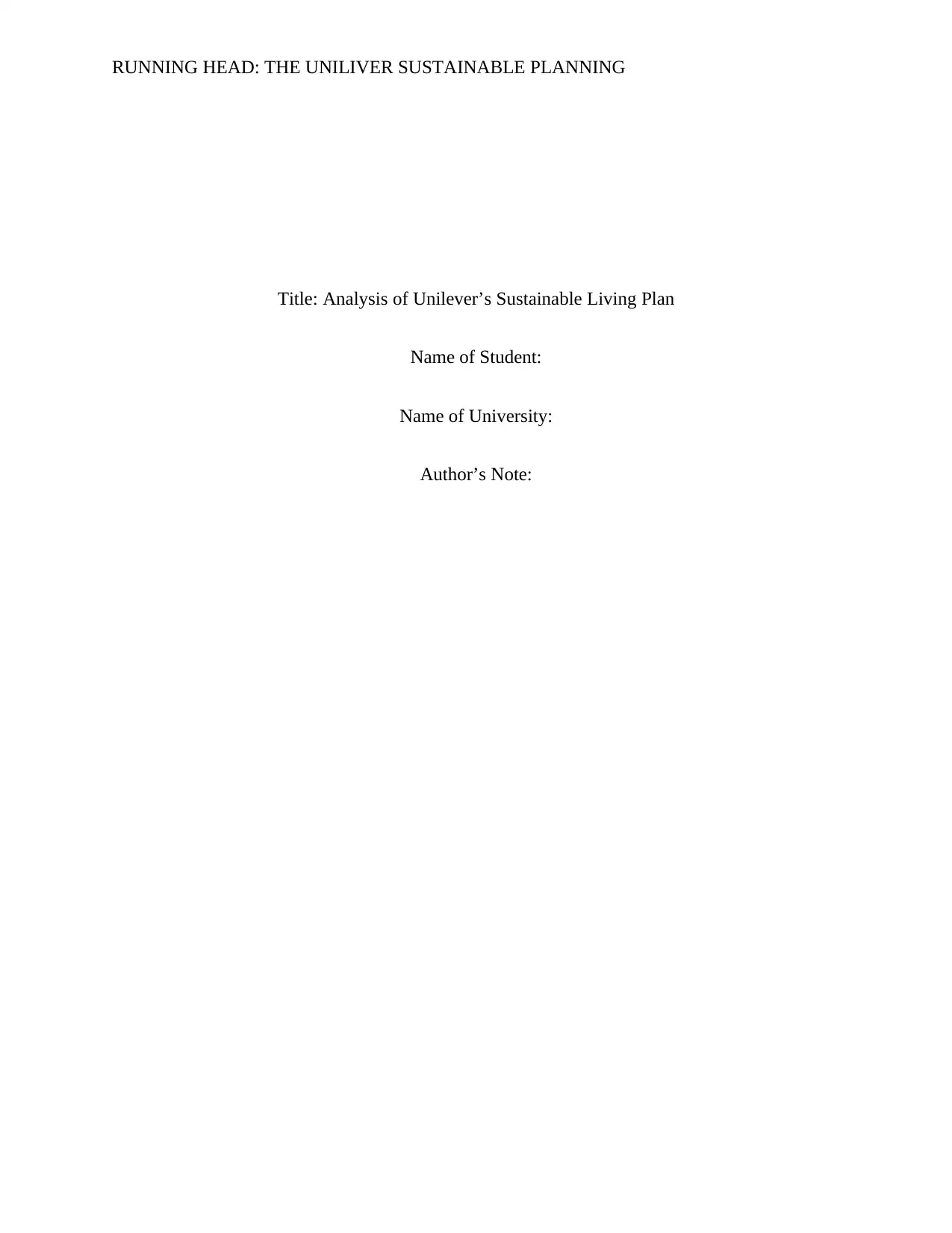
RUNNING HEAD: THE UNILIVER SUSTAINABLE PLANNING
Title: Analysis of Unilever’s Sustainable Living Plan
Name of Student:
Name of University:
Author’s Note:
Title: Analysis of Unilever’s Sustainable Living Plan
Name of Student:
Name of University:
Author’s Note:
Paraphrase This Document
Need a fresh take? Get an instant paraphrase of this document with our AI Paraphraser
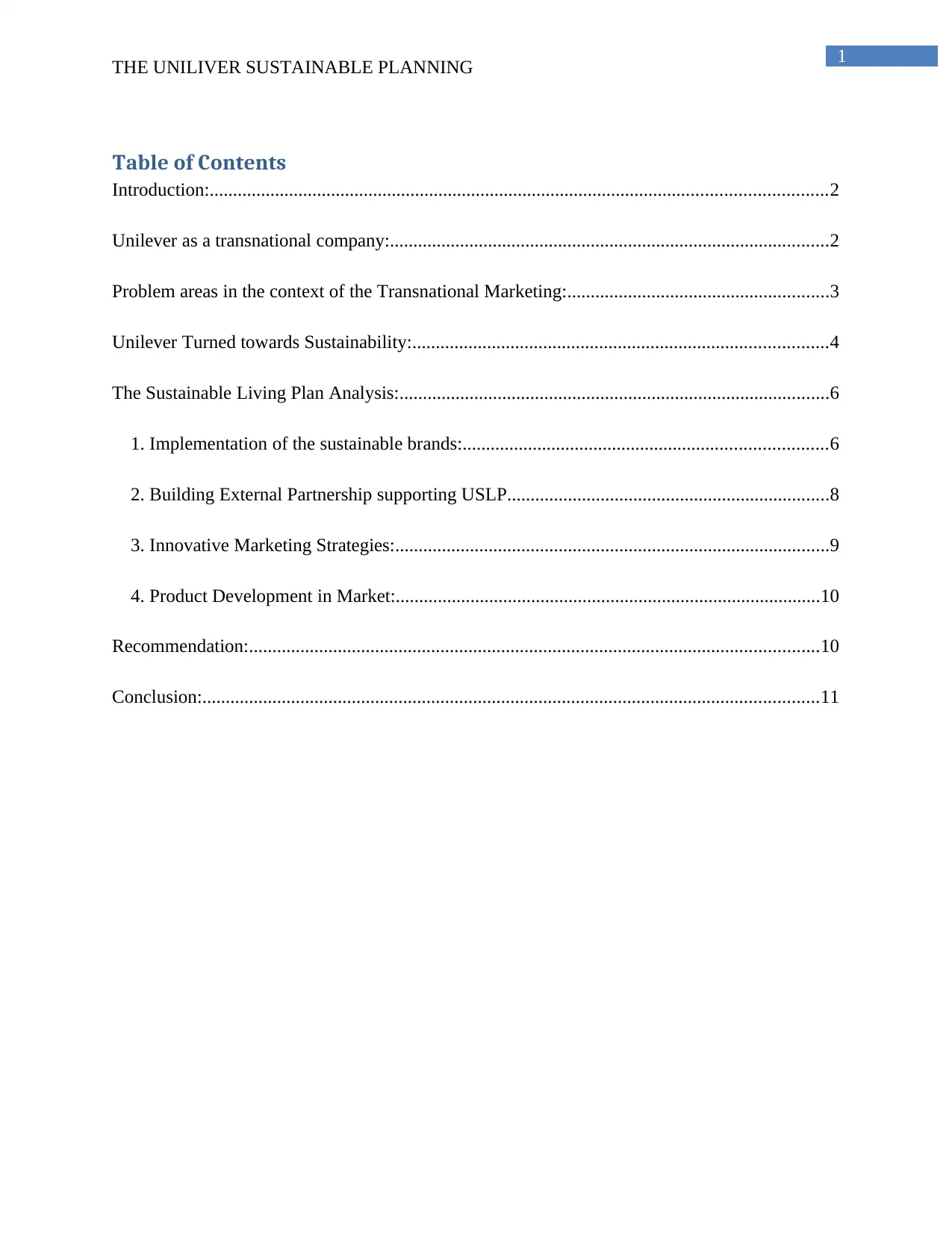
1
THE UNILIVER SUSTAINABLE PLANNING
Table of Contents
Introduction:....................................................................................................................................2
Unilever as a transnational company:..............................................................................................2
Problem areas in the context of the Transnational Marketing:........................................................3
Unilever Turned towards Sustainability:.........................................................................................4
The Sustainable Living Plan Analysis:............................................................................................6
1. Implementation of the sustainable brands:..............................................................................6
2. Building External Partnership supporting USLP.....................................................................8
3. Innovative Marketing Strategies:.............................................................................................9
4. Product Development in Market:...........................................................................................10
Recommendation:..........................................................................................................................10
Conclusion:....................................................................................................................................11
THE UNILIVER SUSTAINABLE PLANNING
Table of Contents
Introduction:....................................................................................................................................2
Unilever as a transnational company:..............................................................................................2
Problem areas in the context of the Transnational Marketing:........................................................3
Unilever Turned towards Sustainability:.........................................................................................4
The Sustainable Living Plan Analysis:............................................................................................6
1. Implementation of the sustainable brands:..............................................................................6
2. Building External Partnership supporting USLP.....................................................................8
3. Innovative Marketing Strategies:.............................................................................................9
4. Product Development in Market:...........................................................................................10
Recommendation:..........................................................................................................................10
Conclusion:....................................................................................................................................11
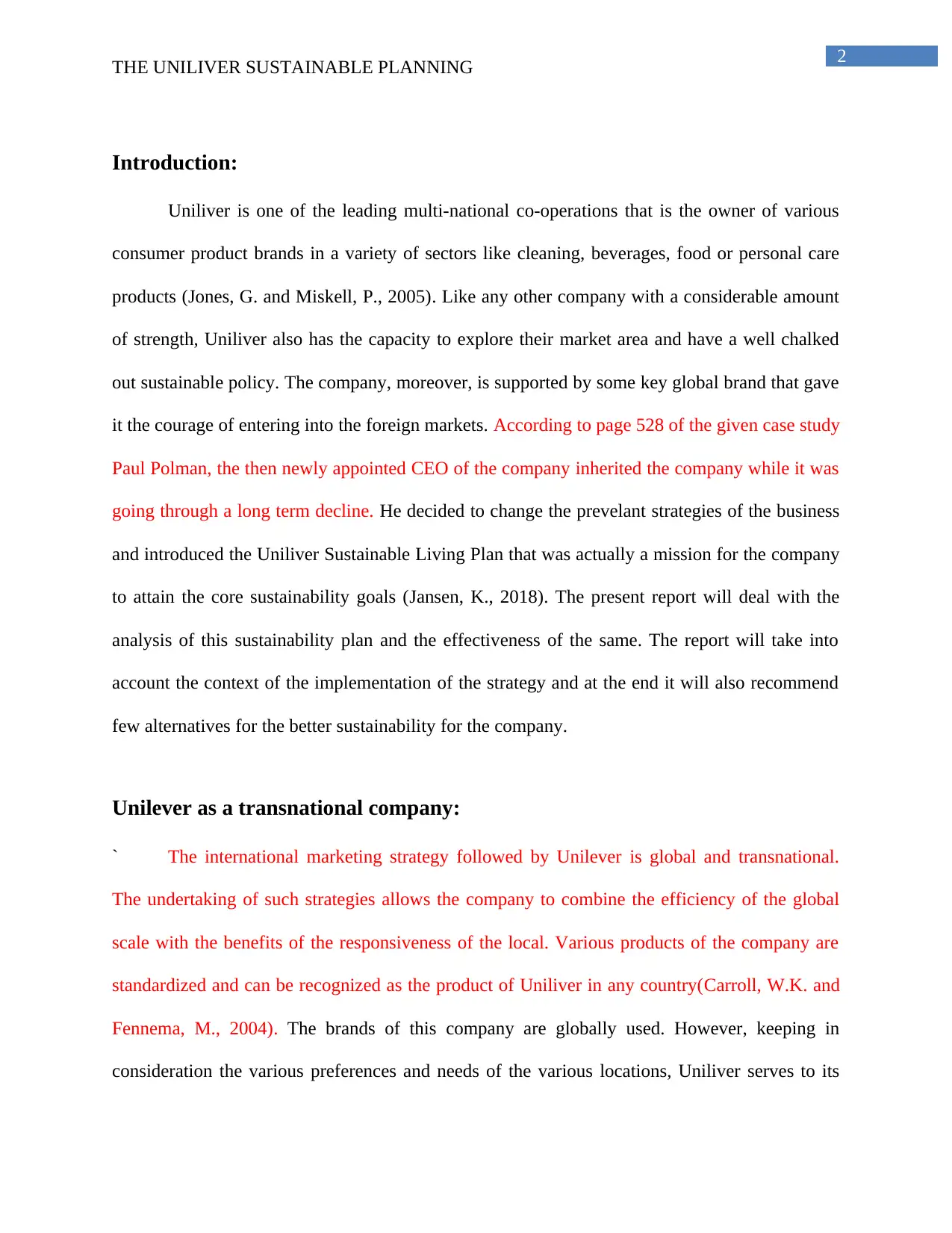
2
THE UNILIVER SUSTAINABLE PLANNING
Introduction:
Uniliver is one of the leading multi-national co-operations that is the owner of various
consumer product brands in a variety of sectors like cleaning, beverages, food or personal care
products (Jones, G. and Miskell, P., 2005). Like any other company with a considerable amount
of strength, Uniliver also has the capacity to explore their market area and have a well chalked
out sustainable policy. The company, moreover, is supported by some key global brand that gave
it the courage of entering into the foreign markets. According to page 528 of the given case study
Paul Polman, the then newly appointed CEO of the company inherited the company while it was
going through a long term decline. He decided to change the prevelant strategies of the business
and introduced the Uniliver Sustainable Living Plan that was actually a mission for the company
to attain the core sustainability goals (Jansen, K., 2018). The present report will deal with the
analysis of this sustainability plan and the effectiveness of the same. The report will take into
account the context of the implementation of the strategy and at the end it will also recommend
few alternatives for the better sustainability for the company.
Unilever as a transnational company:
` The international marketing strategy followed by Unilever is global and transnational.
The undertaking of such strategies allows the company to combine the efficiency of the global
scale with the benefits of the responsiveness of the local. Various products of the company are
standardized and can be recognized as the product of Uniliver in any country(Carroll, W.K. and
Fennema, M., 2004). The brands of this company are globally used. However, keeping in
consideration the various preferences and needs of the various locations, Uniliver serves to its
THE UNILIVER SUSTAINABLE PLANNING
Introduction:
Uniliver is one of the leading multi-national co-operations that is the owner of various
consumer product brands in a variety of sectors like cleaning, beverages, food or personal care
products (Jones, G. and Miskell, P., 2005). Like any other company with a considerable amount
of strength, Uniliver also has the capacity to explore their market area and have a well chalked
out sustainable policy. The company, moreover, is supported by some key global brand that gave
it the courage of entering into the foreign markets. According to page 528 of the given case study
Paul Polman, the then newly appointed CEO of the company inherited the company while it was
going through a long term decline. He decided to change the prevelant strategies of the business
and introduced the Uniliver Sustainable Living Plan that was actually a mission for the company
to attain the core sustainability goals (Jansen, K., 2018). The present report will deal with the
analysis of this sustainability plan and the effectiveness of the same. The report will take into
account the context of the implementation of the strategy and at the end it will also recommend
few alternatives for the better sustainability for the company.
Unilever as a transnational company:
` The international marketing strategy followed by Unilever is global and transnational.
The undertaking of such strategies allows the company to combine the efficiency of the global
scale with the benefits of the responsiveness of the local. Various products of the company are
standardized and can be recognized as the product of Uniliver in any country(Carroll, W.K. and
Fennema, M., 2004). The brands of this company are globally used. However, keeping in
consideration the various preferences and needs of the various locations, Uniliver serves to its
⊘ This is a preview!⊘
Do you want full access?
Subscribe today to unlock all pages.

Trusted by 1+ million students worldwide
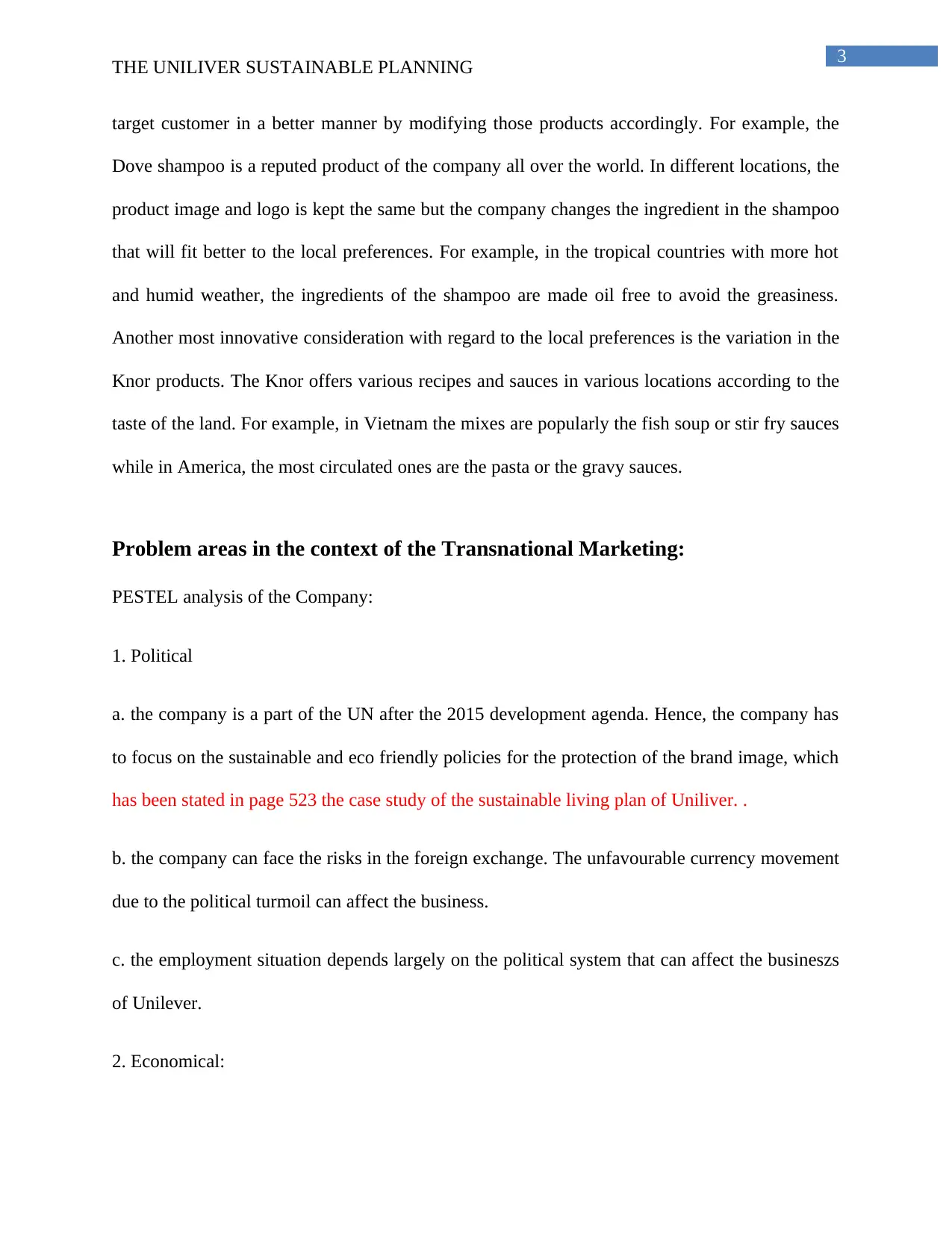
3
THE UNILIVER SUSTAINABLE PLANNING
target customer in a better manner by modifying those products accordingly. For example, the
Dove shampoo is a reputed product of the company all over the world. In different locations, the
product image and logo is kept the same but the company changes the ingredient in the shampoo
that will fit better to the local preferences. For example, in the tropical countries with more hot
and humid weather, the ingredients of the shampoo are made oil free to avoid the greasiness.
Another most innovative consideration with regard to the local preferences is the variation in the
Knor products. The Knor offers various recipes and sauces in various locations according to the
taste of the land. For example, in Vietnam the mixes are popularly the fish soup or stir fry sauces
while in America, the most circulated ones are the pasta or the gravy sauces.
Problem areas in the context of the Transnational Marketing:
PESTEL analysis of the Company:
1. Political
a. the company is a part of the UN after the 2015 development agenda. Hence, the company has
to focus on the sustainable and eco friendly policies for the protection of the brand image, which
has been stated in page 523 the case study of the sustainable living plan of Uniliver. .
b. the company can face the risks in the foreign exchange. The unfavourable currency movement
due to the political turmoil can affect the business.
c. the employment situation depends largely on the political system that can affect the busineszs
of Unilever.
2. Economical:
THE UNILIVER SUSTAINABLE PLANNING
target customer in a better manner by modifying those products accordingly. For example, the
Dove shampoo is a reputed product of the company all over the world. In different locations, the
product image and logo is kept the same but the company changes the ingredient in the shampoo
that will fit better to the local preferences. For example, in the tropical countries with more hot
and humid weather, the ingredients of the shampoo are made oil free to avoid the greasiness.
Another most innovative consideration with regard to the local preferences is the variation in the
Knor products. The Knor offers various recipes and sauces in various locations according to the
taste of the land. For example, in Vietnam the mixes are popularly the fish soup or stir fry sauces
while in America, the most circulated ones are the pasta or the gravy sauces.
Problem areas in the context of the Transnational Marketing:
PESTEL analysis of the Company:
1. Political
a. the company is a part of the UN after the 2015 development agenda. Hence, the company has
to focus on the sustainable and eco friendly policies for the protection of the brand image, which
has been stated in page 523 the case study of the sustainable living plan of Uniliver. .
b. the company can face the risks in the foreign exchange. The unfavourable currency movement
due to the political turmoil can affect the business.
c. the employment situation depends largely on the political system that can affect the busineszs
of Unilever.
2. Economical:
Paraphrase This Document
Need a fresh take? Get an instant paraphrase of this document with our AI Paraphraser
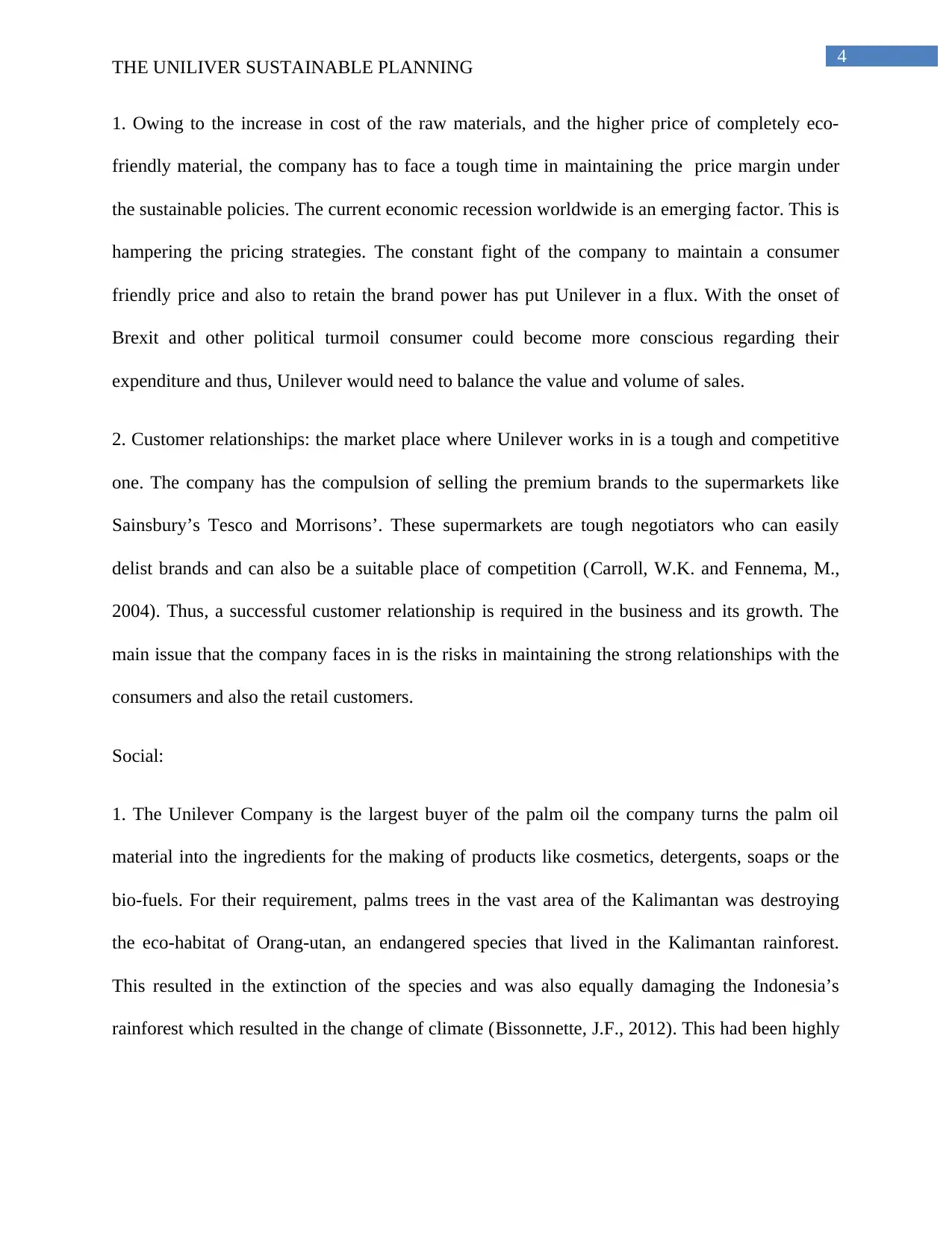
4
THE UNILIVER SUSTAINABLE PLANNING
1. Owing to the increase in cost of the raw materials, and the higher price of completely eco-
friendly material, the company has to face a tough time in maintaining the price margin under
the sustainable policies. The current economic recession worldwide is an emerging factor. This is
hampering the pricing strategies. The constant fight of the company to maintain a consumer
friendly price and also to retain the brand power has put Unilever in a flux. With the onset of
Brexit and other political turmoil consumer could become more conscious regarding their
expenditure and thus, Unilever would need to balance the value and volume of sales.
2. Customer relationships: the market place where Unilever works in is a tough and competitive
one. The company has the compulsion of selling the premium brands to the supermarkets like
Sainsbury’s Tesco and Morrisons’. These supermarkets are tough negotiators who can easily
delist brands and can also be a suitable place of competition (Carroll, W.K. and Fennema, M.,
2004). Thus, a successful customer relationship is required in the business and its growth. The
main issue that the company faces in is the risks in maintaining the strong relationships with the
consumers and also the retail customers.
Social:
1. The Unilever Company is the largest buyer of the palm oil the company turns the palm oil
material into the ingredients for the making of products like cosmetics, detergents, soaps or the
bio-fuels. For their requirement, palms trees in the vast area of the Kalimantan was destroying
the eco-habitat of Orang-utan, an endangered species that lived in the Kalimantan rainforest.
This resulted in the extinction of the species and was also equally damaging the Indonesia’s
rainforest which resulted in the change of climate (Bissonnette, J.F., 2012). This had been highly
THE UNILIVER SUSTAINABLE PLANNING
1. Owing to the increase in cost of the raw materials, and the higher price of completely eco-
friendly material, the company has to face a tough time in maintaining the price margin under
the sustainable policies. The current economic recession worldwide is an emerging factor. This is
hampering the pricing strategies. The constant fight of the company to maintain a consumer
friendly price and also to retain the brand power has put Unilever in a flux. With the onset of
Brexit and other political turmoil consumer could become more conscious regarding their
expenditure and thus, Unilever would need to balance the value and volume of sales.
2. Customer relationships: the market place where Unilever works in is a tough and competitive
one. The company has the compulsion of selling the premium brands to the supermarkets like
Sainsbury’s Tesco and Morrisons’. These supermarkets are tough negotiators who can easily
delist brands and can also be a suitable place of competition (Carroll, W.K. and Fennema, M.,
2004). Thus, a successful customer relationship is required in the business and its growth. The
main issue that the company faces in is the risks in maintaining the strong relationships with the
consumers and also the retail customers.
Social:
1. The Unilever Company is the largest buyer of the palm oil the company turns the palm oil
material into the ingredients for the making of products like cosmetics, detergents, soaps or the
bio-fuels. For their requirement, palms trees in the vast area of the Kalimantan was destroying
the eco-habitat of Orang-utan, an endangered species that lived in the Kalimantan rainforest.
This resulted in the extinction of the species and was also equally damaging the Indonesia’s
rainforest which resulted in the change of climate (Bissonnette, J.F., 2012). This had been highly
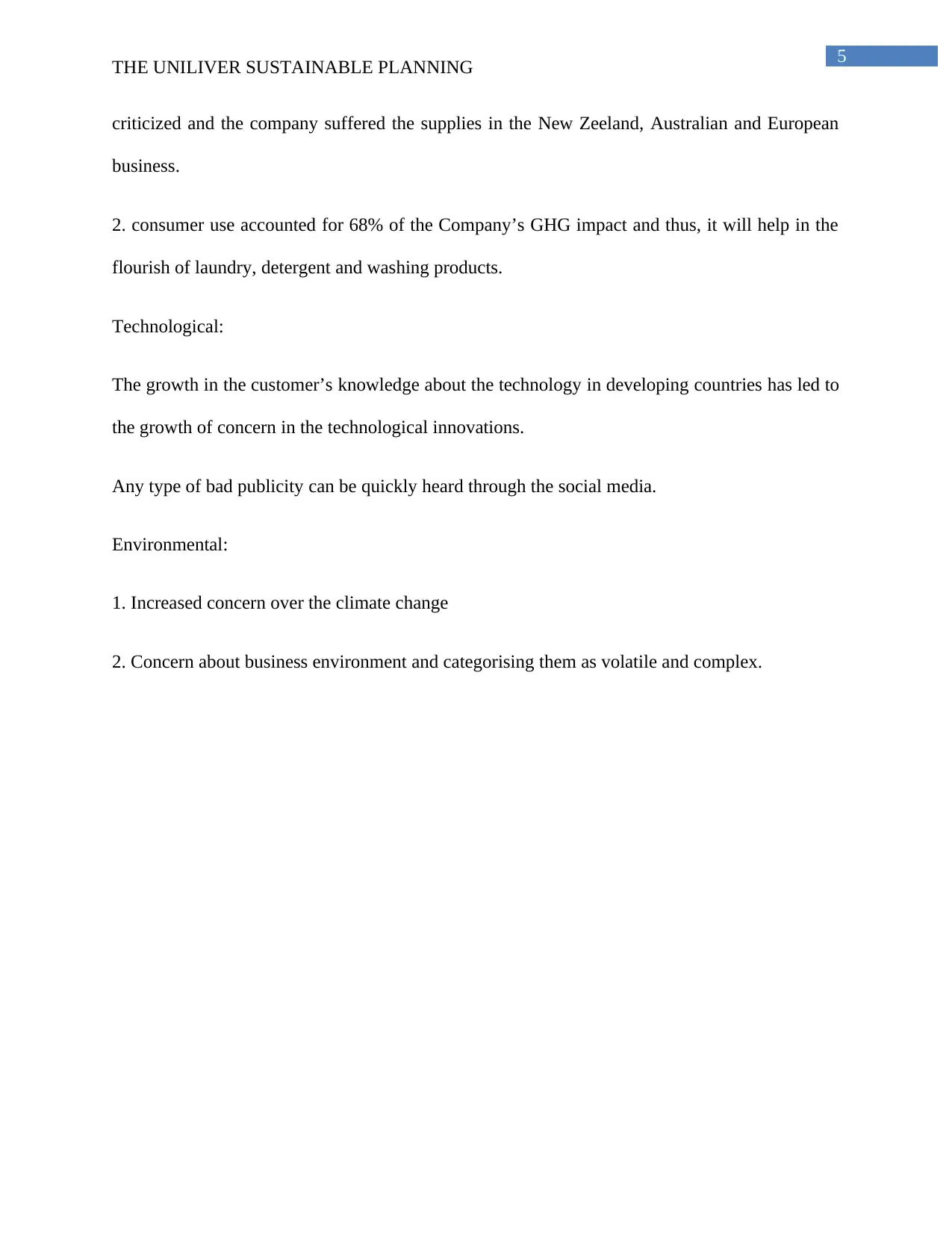
5
THE UNILIVER SUSTAINABLE PLANNING
criticized and the company suffered the supplies in the New Zeeland, Australian and European
business.
2. consumer use accounted for 68% of the Company’s GHG impact and thus, it will help in the
flourish of laundry, detergent and washing products.
Technological:
The growth in the customer’s knowledge about the technology in developing countries has led to
the growth of concern in the technological innovations.
Any type of bad publicity can be quickly heard through the social media.
Environmental:
1. Increased concern over the climate change
2. Concern about business environment and categorising them as volatile and complex.
THE UNILIVER SUSTAINABLE PLANNING
criticized and the company suffered the supplies in the New Zeeland, Australian and European
business.
2. consumer use accounted for 68% of the Company’s GHG impact and thus, it will help in the
flourish of laundry, detergent and washing products.
Technological:
The growth in the customer’s knowledge about the technology in developing countries has led to
the growth of concern in the technological innovations.
Any type of bad publicity can be quickly heard through the social media.
Environmental:
1. Increased concern over the climate change
2. Concern about business environment and categorising them as volatile and complex.
⊘ This is a preview!⊘
Do you want full access?
Subscribe today to unlock all pages.

Trusted by 1+ million students worldwide
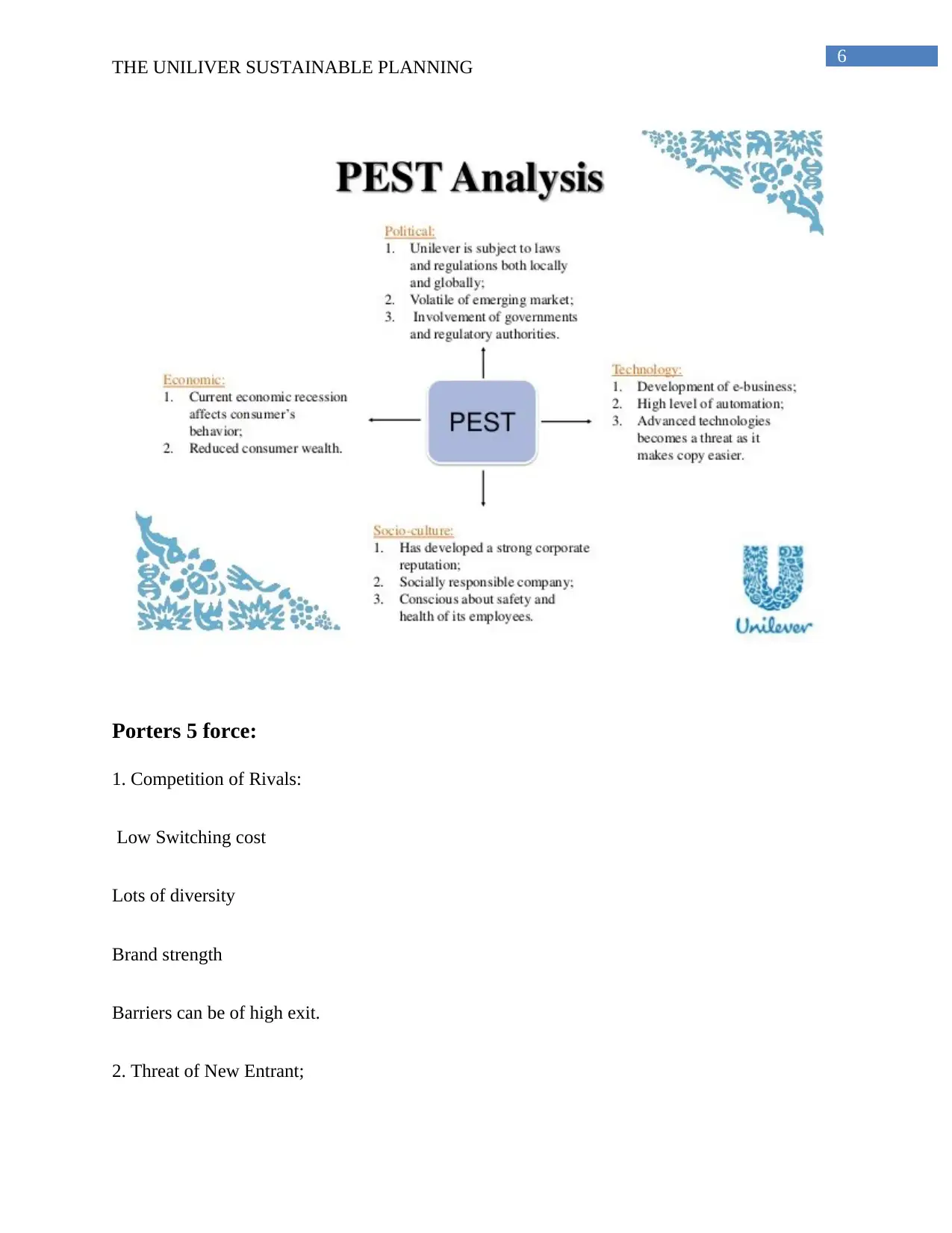
6
THE UNILIVER SUSTAINABLE PLANNING
Porters 5 force:
1. Competition of Rivals:
Low Switching cost
Lots of diversity
Brand strength
Barriers can be of high exit.
2. Threat of New Entrant;
THE UNILIVER SUSTAINABLE PLANNING
Porters 5 force:
1. Competition of Rivals:
Low Switching cost
Lots of diversity
Brand strength
Barriers can be of high exit.
2. Threat of New Entrant;
Paraphrase This Document
Need a fresh take? Get an instant paraphrase of this document with our AI Paraphraser
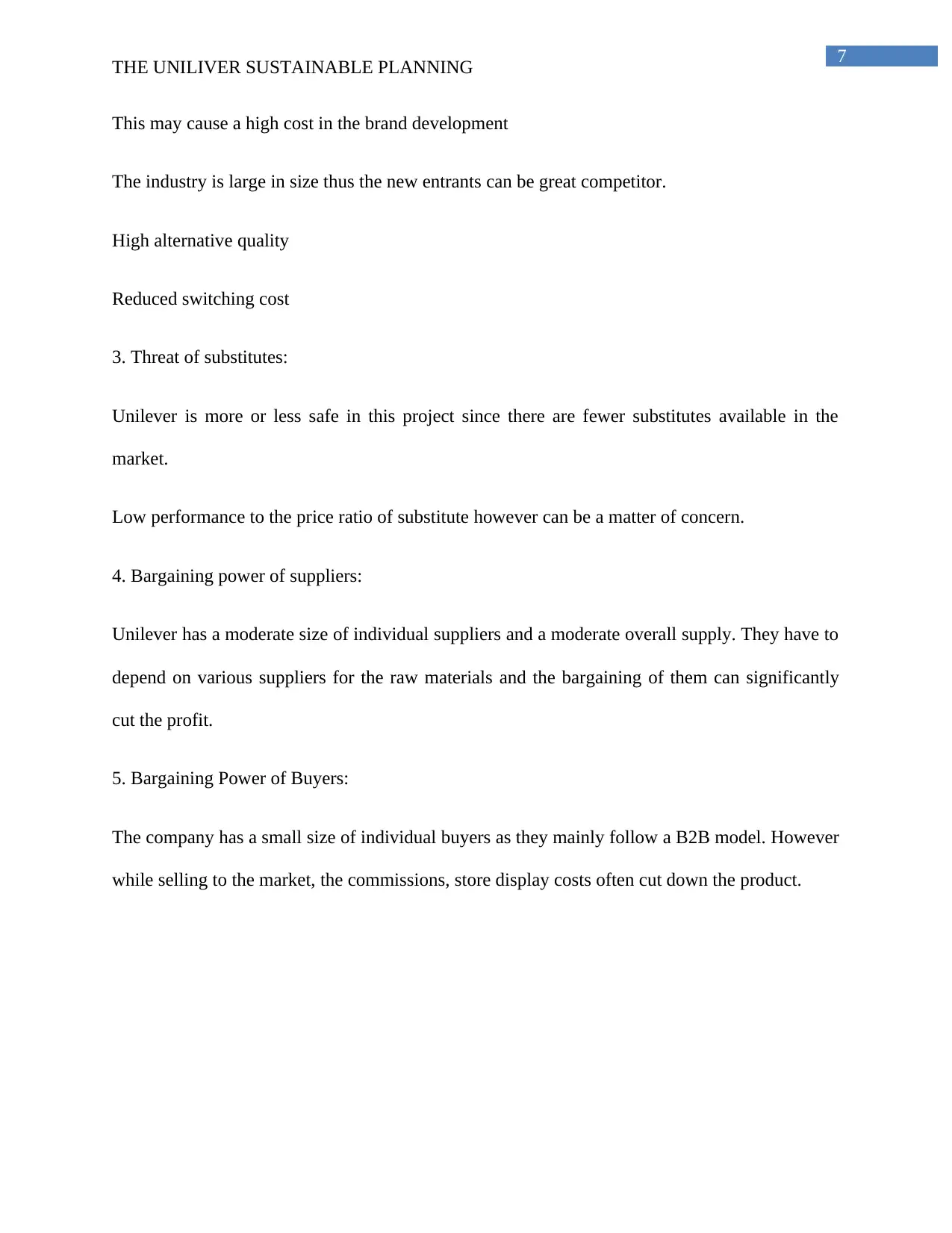
7
THE UNILIVER SUSTAINABLE PLANNING
This may cause a high cost in the brand development
The industry is large in size thus the new entrants can be great competitor.
High alternative quality
Reduced switching cost
3. Threat of substitutes:
Unilever is more or less safe in this project since there are fewer substitutes available in the
market.
Low performance to the price ratio of substitute however can be a matter of concern.
4. Bargaining power of suppliers:
Unilever has a moderate size of individual suppliers and a moderate overall supply. They have to
depend on various suppliers for the raw materials and the bargaining of them can significantly
cut the profit.
5. Bargaining Power of Buyers:
The company has a small size of individual buyers as they mainly follow a B2B model. However
while selling to the market, the commissions, store display costs often cut down the product.
THE UNILIVER SUSTAINABLE PLANNING
This may cause a high cost in the brand development
The industry is large in size thus the new entrants can be great competitor.
High alternative quality
Reduced switching cost
3. Threat of substitutes:
Unilever is more or less safe in this project since there are fewer substitutes available in the
market.
Low performance to the price ratio of substitute however can be a matter of concern.
4. Bargaining power of suppliers:
Unilever has a moderate size of individual suppliers and a moderate overall supply. They have to
depend on various suppliers for the raw materials and the bargaining of them can significantly
cut the profit.
5. Bargaining Power of Buyers:
The company has a small size of individual buyers as they mainly follow a B2B model. However
while selling to the market, the commissions, store display costs often cut down the product.
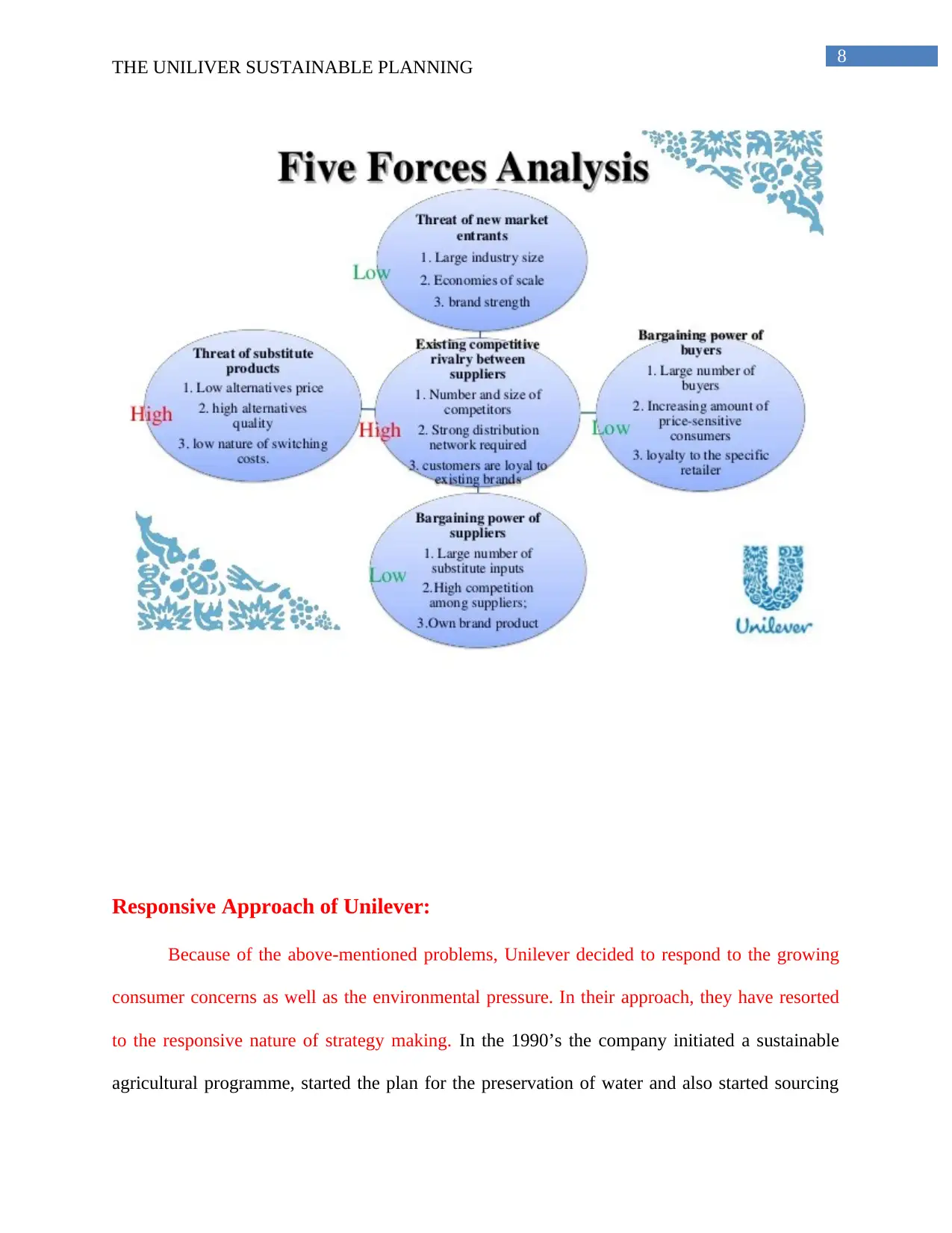
8
THE UNILIVER SUSTAINABLE PLANNING
Responsive Approach of Unilever:
Because of the above-mentioned problems, Unilever decided to respond to the growing
consumer concerns as well as the environmental pressure. In their approach, they have resorted
to the responsive nature of strategy making. In the 1990’s the company initiated a sustainable
agricultural programme, started the plan for the preservation of water and also started sourcing
THE UNILIVER SUSTAINABLE PLANNING
Responsive Approach of Unilever:
Because of the above-mentioned problems, Unilever decided to respond to the growing
consumer concerns as well as the environmental pressure. In their approach, they have resorted
to the responsive nature of strategy making. In the 1990’s the company initiated a sustainable
agricultural programme, started the plan for the preservation of water and also started sourcing
⊘ This is a preview!⊘
Do you want full access?
Subscribe today to unlock all pages.

Trusted by 1+ million students worldwide
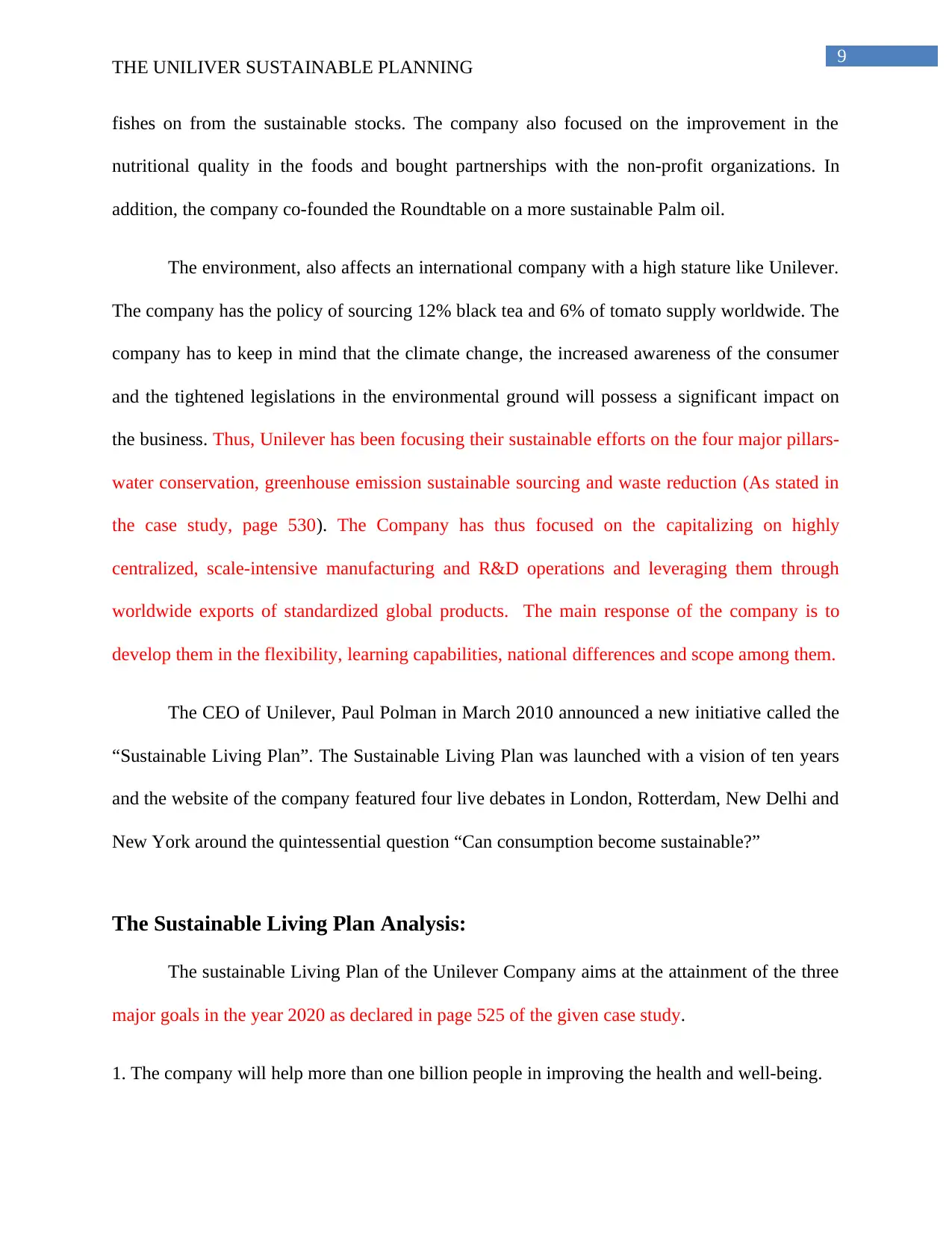
9
THE UNILIVER SUSTAINABLE PLANNING
fishes on from the sustainable stocks. The company also focused on the improvement in the
nutritional quality in the foods and bought partnerships with the non-profit organizations. In
addition, the company co-founded the Roundtable on a more sustainable Palm oil.
The environment, also affects an international company with a high stature like Unilever.
The company has the policy of sourcing 12% black tea and 6% of tomato supply worldwide. The
company has to keep in mind that the climate change, the increased awareness of the consumer
and the tightened legislations in the environmental ground will possess a significant impact on
the business. Thus, Unilever has been focusing their sustainable efforts on the four major pillars-
water conservation, greenhouse emission sustainable sourcing and waste reduction (As stated in
the case study, page 530). The Company has thus focused on the capitalizing on highly
centralized, scale-intensive manufacturing and R&D operations and leveraging them through
worldwide exports of standardized global products. The main response of the company is to
develop them in the flexibility, learning capabilities, national differences and scope among them.
The CEO of Unilever, Paul Polman in March 2010 announced a new initiative called the
“Sustainable Living Plan”. The Sustainable Living Plan was launched with a vision of ten years
and the website of the company featured four live debates in London, Rotterdam, New Delhi and
New York around the quintessential question “Can consumption become sustainable?”
The Sustainable Living Plan Analysis:
The sustainable Living Plan of the Unilever Company aims at the attainment of the three
major goals in the year 2020 as declared in page 525 of the given case study.
1. The company will help more than one billion people in improving the health and well-being.
THE UNILIVER SUSTAINABLE PLANNING
fishes on from the sustainable stocks. The company also focused on the improvement in the
nutritional quality in the foods and bought partnerships with the non-profit organizations. In
addition, the company co-founded the Roundtable on a more sustainable Palm oil.
The environment, also affects an international company with a high stature like Unilever.
The company has the policy of sourcing 12% black tea and 6% of tomato supply worldwide. The
company has to keep in mind that the climate change, the increased awareness of the consumer
and the tightened legislations in the environmental ground will possess a significant impact on
the business. Thus, Unilever has been focusing their sustainable efforts on the four major pillars-
water conservation, greenhouse emission sustainable sourcing and waste reduction (As stated in
the case study, page 530). The Company has thus focused on the capitalizing on highly
centralized, scale-intensive manufacturing and R&D operations and leveraging them through
worldwide exports of standardized global products. The main response of the company is to
develop them in the flexibility, learning capabilities, national differences and scope among them.
The CEO of Unilever, Paul Polman in March 2010 announced a new initiative called the
“Sustainable Living Plan”. The Sustainable Living Plan was launched with a vision of ten years
and the website of the company featured four live debates in London, Rotterdam, New Delhi and
New York around the quintessential question “Can consumption become sustainable?”
The Sustainable Living Plan Analysis:
The sustainable Living Plan of the Unilever Company aims at the attainment of the three
major goals in the year 2020 as declared in page 525 of the given case study.
1. The company will help more than one billion people in improving the health and well-being.
Paraphrase This Document
Need a fresh take? Get an instant paraphrase of this document with our AI Paraphraser
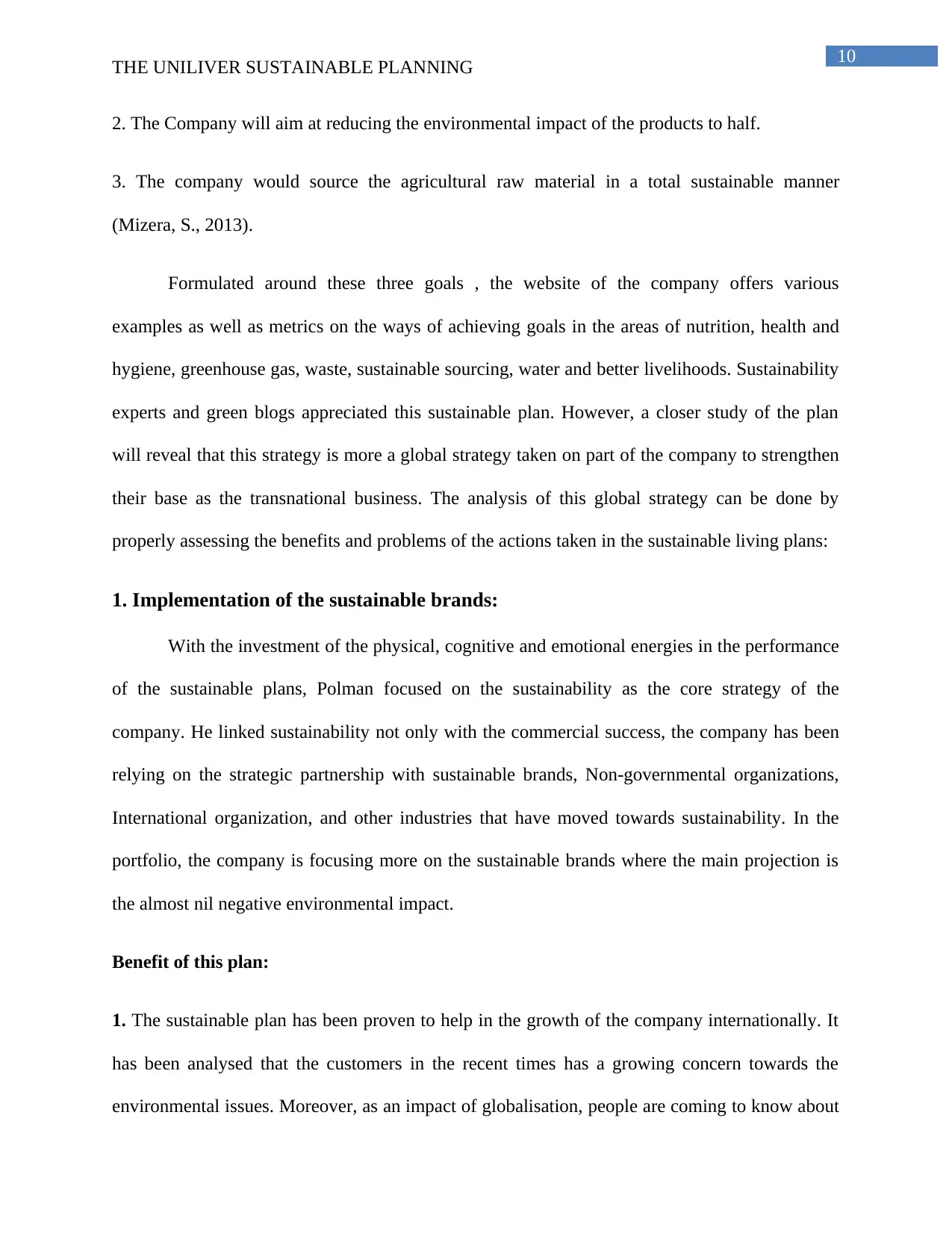
10
THE UNILIVER SUSTAINABLE PLANNING
2. The Company will aim at reducing the environmental impact of the products to half.
3. The company would source the agricultural raw material in a total sustainable manner
(Mizera, S., 2013).
Formulated around these three goals , the website of the company offers various
examples as well as metrics on the ways of achieving goals in the areas of nutrition, health and
hygiene, greenhouse gas, waste, sustainable sourcing, water and better livelihoods. Sustainability
experts and green blogs appreciated this sustainable plan. However, a closer study of the plan
will reveal that this strategy is more a global strategy taken on part of the company to strengthen
their base as the transnational business. The analysis of this global strategy can be done by
properly assessing the benefits and problems of the actions taken in the sustainable living plans:
1. Implementation of the sustainable brands:
With the investment of the physical, cognitive and emotional energies in the performance
of the sustainable plans, Polman focused on the sustainability as the core strategy of the
company. He linked sustainability not only with the commercial success, the company has been
relying on the strategic partnership with sustainable brands, Non-governmental organizations,
International organization, and other industries that have moved towards sustainability. In the
portfolio, the company is focusing more on the sustainable brands where the main projection is
the almost nil negative environmental impact.
Benefit of this plan:
1. The sustainable plan has been proven to help in the growth of the company internationally. It
has been analysed that the customers in the recent times has a growing concern towards the
environmental issues. Moreover, as an impact of globalisation, people are coming to know about
THE UNILIVER SUSTAINABLE PLANNING
2. The Company will aim at reducing the environmental impact of the products to half.
3. The company would source the agricultural raw material in a total sustainable manner
(Mizera, S., 2013).
Formulated around these three goals , the website of the company offers various
examples as well as metrics on the ways of achieving goals in the areas of nutrition, health and
hygiene, greenhouse gas, waste, sustainable sourcing, water and better livelihoods. Sustainability
experts and green blogs appreciated this sustainable plan. However, a closer study of the plan
will reveal that this strategy is more a global strategy taken on part of the company to strengthen
their base as the transnational business. The analysis of this global strategy can be done by
properly assessing the benefits and problems of the actions taken in the sustainable living plans:
1. Implementation of the sustainable brands:
With the investment of the physical, cognitive and emotional energies in the performance
of the sustainable plans, Polman focused on the sustainability as the core strategy of the
company. He linked sustainability not only with the commercial success, the company has been
relying on the strategic partnership with sustainable brands, Non-governmental organizations,
International organization, and other industries that have moved towards sustainability. In the
portfolio, the company is focusing more on the sustainable brands where the main projection is
the almost nil negative environmental impact.
Benefit of this plan:
1. The sustainable plan has been proven to help in the growth of the company internationally. It
has been analysed that the customers in the recent times has a growing concern towards the
environmental issues. Moreover, as an impact of globalisation, people are coming to know about
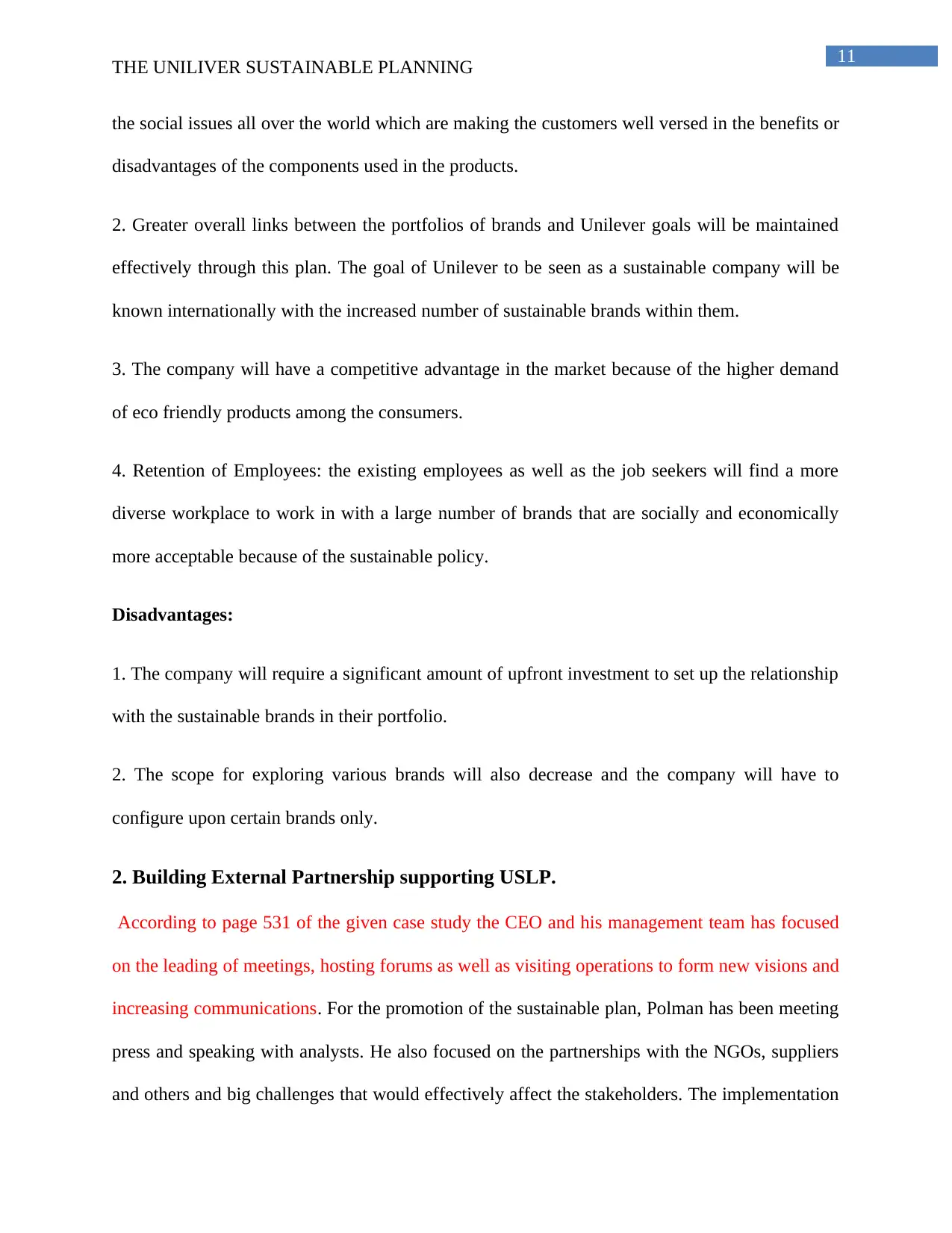
11
THE UNILIVER SUSTAINABLE PLANNING
the social issues all over the world which are making the customers well versed in the benefits or
disadvantages of the components used in the products.
2. Greater overall links between the portfolios of brands and Unilever goals will be maintained
effectively through this plan. The goal of Unilever to be seen as a sustainable company will be
known internationally with the increased number of sustainable brands within them.
3. The company will have a competitive advantage in the market because of the higher demand
of eco friendly products among the consumers.
4. Retention of Employees: the existing employees as well as the job seekers will find a more
diverse workplace to work in with a large number of brands that are socially and economically
more acceptable because of the sustainable policy.
Disadvantages:
1. The company will require a significant amount of upfront investment to set up the relationship
with the sustainable brands in their portfolio.
2. The scope for exploring various brands will also decrease and the company will have to
configure upon certain brands only.
2. Building External Partnership supporting USLP.
According to page 531 of the given case study the CEO and his management team has focused
on the leading of meetings, hosting forums as well as visiting operations to form new visions and
increasing communications. For the promotion of the sustainable plan, Polman has been meeting
press and speaking with analysts. He also focused on the partnerships with the NGOs, suppliers
and others and big challenges that would effectively affect the stakeholders. The implementation
THE UNILIVER SUSTAINABLE PLANNING
the social issues all over the world which are making the customers well versed in the benefits or
disadvantages of the components used in the products.
2. Greater overall links between the portfolios of brands and Unilever goals will be maintained
effectively through this plan. The goal of Unilever to be seen as a sustainable company will be
known internationally with the increased number of sustainable brands within them.
3. The company will have a competitive advantage in the market because of the higher demand
of eco friendly products among the consumers.
4. Retention of Employees: the existing employees as well as the job seekers will find a more
diverse workplace to work in with a large number of brands that are socially and economically
more acceptable because of the sustainable policy.
Disadvantages:
1. The company will require a significant amount of upfront investment to set up the relationship
with the sustainable brands in their portfolio.
2. The scope for exploring various brands will also decrease and the company will have to
configure upon certain brands only.
2. Building External Partnership supporting USLP.
According to page 531 of the given case study the CEO and his management team has focused
on the leading of meetings, hosting forums as well as visiting operations to form new visions and
increasing communications. For the promotion of the sustainable plan, Polman has been meeting
press and speaking with analysts. He also focused on the partnerships with the NGOs, suppliers
and others and big challenges that would effectively affect the stakeholders. The implementation
⊘ This is a preview!⊘
Do you want full access?
Subscribe today to unlock all pages.

Trusted by 1+ million students worldwide
1 out of 18
Related Documents
Your All-in-One AI-Powered Toolkit for Academic Success.
+13062052269
info@desklib.com
Available 24*7 on WhatsApp / Email
![[object Object]](/_next/static/media/star-bottom.7253800d.svg)
Unlock your academic potential
Copyright © 2020–2025 A2Z Services. All Rights Reserved. Developed and managed by ZUCOL.





